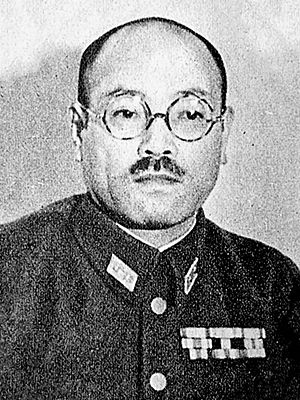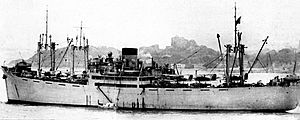Battle of Hong Kong order of battle facts for kids
The Battle of Hong Kong, fought from December 8 to December 25, 1941, was one of the first major battles in the Pacific War during World War II. This article explains which military groups and leaders were involved in this important battle. It's like a "who's who" of the armies, navies, and air forces that fought.
The Forces That Fought in Hong Kong
Allied Forces
The Allied forces defending Hong Kong were mainly from the British Commonwealth. They included soldiers from Britain, Canada, India, and local Hong Kong volunteers.
Ground Troops
The overall commander for Hong Kong was Major General Christopher Maltby. He led all the different groups defending the area.
The main ground forces included:
- Soldiers from the Royal Scots Regiment and the Middlesex Regiment from Britain.
- Canadian soldiers from the Royal Rifles of Canada and the Winnipeg Grenadiers.
- Indian soldiers from the Rajput Regiment and the 14th Punjab Regiment.
- Local forces like the Hong Kong Chinese Regiment and the Hong Kong Volunteer Defence Corps. This volunteer group had infantry, artillery, engineers, and other support units.
- The Royal Artillery provided powerful guns, including coastal defenses and anti-aircraft weapons.
- The Royal Engineers were in charge of building and maintaining defenses.
These infantry units were organized into two main defensive groups:
- The Kowloon Infantry Brigade, led by Brigadier Cedric Wallis.
- The Hong Kong Infantry Brigade, led by Brigadier J. K. Lawson.
Many other support groups helped the soldiers, including those for supplies, medical care, and communications.
Civilian Support
Civilians also played a role in defending Hong Kong. These included:
- The Hong Kong Police Force, which had Indian and Chinese reserve companies.
- The Fire Brigade, which helped with fires caused by attacks.
- Air Raid Precautions teams, who helped people stay safe during air raids.
- The St. John's Ambulance, which provided medical help.
- Various auxiliary services that helped with communications, transport, and medical support.
The Royal Navy had a small fleet in Hong Kong, commanded by Captain Alfred C. Collinson. Their ships included:
- The shore station HMS Tamar (shore station).
- Destroyers like HMS Thracian, HMS Scout, and HMS Thanet.
- Smaller gunboats and patrol vessels like HMS Robin and HMS Cicala.
- The Hong Kong Royal Naval Volunteer Reserve, made up of local sailors.
- A group of Motor Torpedo Boats (MTBs), which were fast, small boats designed to attack larger ships with torpedoes.
The Merchant Navy also had many cargo ships in the area, though they were not fighting ships.
Air Power
The Allied air forces in Hong Kong were very small. They included:
- The Fleet Air Arm of the Royal Navy, with a few Supermarine Walrus planes. These were amphibious planes, meaning they could land on water.
- The Royal Air Force (RAF) had a few Vickers Vildebeest planes.
- The HKVDC Flight, a local volunteer air unit, had a few training planes like the Avro 621 Tutor and Hornet Moth biplanes.
Japanese Forces
The Japanese forces attacking Hong Kong were much larger and well-equipped.
Ground Troops
The main Japanese force was the 23rd Army, led by Lieutenant General Takashi Sakai. His Chief of Staff was Major General Tadamichi Kuribayashi.
The core of the Japanese ground forces was the 38th Division, commanded by Lieutenant General Tadayoshi Sano. This division included:
- Several infantry regiments, such as the 228th, 229th, and 230th Infantry Regiments.
- Artillery units with mountain guns and heavy field guns.
- Engineer regiments for building bridges and clearing obstacles.
- Logistic regiments to handle supplies.
Other specialized units, like mortar battalions and quick-firing gun battalions, also supported the main attack.
The Japanese naval forces were part of the 2nd China Fleet, commanded by Vice Admiral Masaichi Niimi.
Their fleet included:
- The seaplane tender Kamikawa Maru, which carried planes like the Kawanishi E7K and Kugisho B3Y.
- A "Bombardment Group" with ships like the cruiser Isuzu and several destroyers (Tsuga, Ikazuchi, Inazuma). They also had torpedo boats.
- An "Attack Group" with gunboats like Uji and other smaller vessels.
Air Power
The Japanese air forces were much stronger than the Allied air forces in Hong Kong. They included:
- The 23rd Army Air Unit, which had many planes.
- The 45th Flying Sentai, equipped with 29 Kawasaki Ki-32 bomber planes.
- The 10th Independent Chutai, with 13 Nakajima Ki-27 fighter planes.
- Reconnaissance planes like the Mitsubishi Ki-15 and Tachikawa Ki-36.
- The Kanoya Air Group, another important air unit.
These forces show the different strengths and types of military units that fought in the Battle of Hong Kong.
See also
- List of orders of battle
- British Forces Overseas Hong Kong
- C Force





